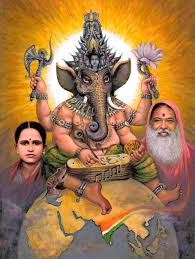Anaghastami- in this ritual, Lord Anagha Deva (Dattatreya) and spouse Anagha Devi together along with their 8 children are invoked and worshipped. It is performed on the 8th day following the full moon. It is primarily performed on the 8th day of the dark fortnight in the month of Margashira (9th month as per Hindu calender that falls between December/ January). In addition, it can also be performed on the 8th day of the waning fortnight in any other month.
Before starting the puja in the sheet before you, write the seed-syllables ‘dram’ and ‘sreem’. First one should contemplate on Anagha Devi and then on Lord Datta. Anagha Devi is the ever-effulgent Supreme Energy that resides in Datta’s heart. Just as one visualizes Goddess Sridevi as seated in the heart of Lord Venkateshwara, here one should mentally visualize Anagha Devi as residing in the heart of Lord Datta.
This vrata was extremely popular in the past yugas. It has been performed by Lord Rama, Krishna, Buddha, Parashurama, Kartaviryarjuna and the like. Maharishi Vashistha sought that King Dasharatha should perform this vrata before the coronation of Lord Rama. Setting aside this request, the king got involved in making arrangements for Rama’s coronation. Hence it was left incomplete. Soon Rama had to leave on a 14 year exile. At the end of the period, Rama installed a Shiva Linga in Rameshwaram, and before His coronation together with Sita performed the Anaghastami Vrata. Therefore He completed what his father had left incomplete.
Krishna too performed this vrata. Towards the end of the period of exile, while in disguise at the King Virata’s palace, just before Arjuna set out for the battle to get back the cows belonging to the king, Yudhisthira (the eldest of the Pandavas) performed this vrata. They were rewarded thereafter with the kingship itself.
All of you who have read Datta Darshanam are familiar with the story of how Emperor Kartaviryarjuna performed this vrata and of the supreme boons he received from Datta. Parashurama, who was also a disciple of Lord Datta, performed this ritual after annihilating all the Kshatriyas in the world. It is said that before Buddha set out of his house in search of truth, he had performed this vrata within the palace.
To perform this vrata there are no caste barriers. To dispel the theories that only those from higher castes were eligible to perform it, this vrata almost originated in the house of a poor man belonging to the lowest caste. Datta Swami himself came in disguise to the house of that poor man and helped him complete the vrata. He asked the poor man to arrange the kalasha (pot for the worship) or 8 betel leaves in a plate and to complete the ritual with the available ingredients and materials.
Devotion and dedication are the most critical and necessary materials for this puja. For offering to the Lord, pancha karjaya, fruits or any available vegetarian food at home would suffice. When Datta, who was in disguise was helping the poor man to complete the ritual, he insisted upon the necessity of a form on whom he could focus. The Lord whose compassion is limitless blessed that devotee with the darshan of Anagha Devi. The devotee was transformed into a learned pundit. He had the divine vision of Lord Datta, the embodiment of the Trinity.
In addition to knowledge and liberation, this Lord blesses the person who performs this ritual with worldly prosperity and worldly knowledge.
This vrata went away from public memory due to the passage of time. Also Datta and his nature (essence or tattva) were forgotten. Time has come for its revival. That is why Swamiji is preaching at length about it.
The 8 supernatural powers (ashta siddhis) have been described as the 8 sons of Datta. This Lord is immensely pleased when the devotee merely thinks about him. This ritual can be done every month on the 8th day after the full moon (ashtami). The white, red and yellow threads are enjoined to form a toram; a sacred thread. This sacred thread is tied to the right wrist after the puja.
- Bhaktimala June 1985
